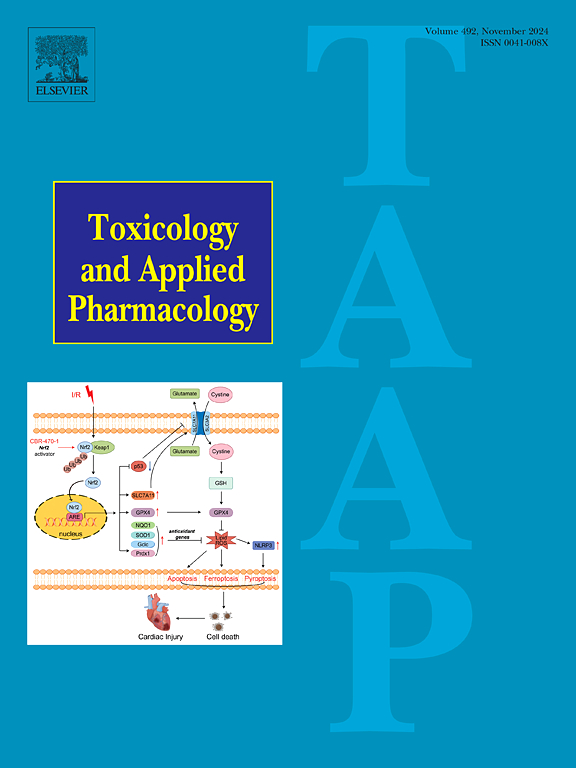Repurposing of cabergoline to improve cognitive decline in D-galactose-injected ovariectomized rats: Modulation of AKT/mTOR, GLT-1/P38-MAPK, and ERK1/2 signaling pathways
IF 3.3
3区 医学
Q2 PHARMACOLOGY & PHARMACY
引用次数: 0
Abstract
Dopamine is involved in many physiological functions including reward phenomenon, motor, learning, and memory functions. Dopamine receptor agonists have been shown to reduce amyloid (Aβ) deposition, enhance memory, and improve cortical plasticity in experimental studies and Alzheimer's disease (AD) patients; however, the molecular mechanisms involved haven't been investigated yet. The target of this investigation was to elucidate the modulatory effects of cabergoline (CAB), a dopamine receptor agonist, against AD. Ovariectomized rats were injected with D-galactose (150 mg/kg/day, i.p) for ten weeks to exacerbate AD. CAB administration (1 mg/kg/day, i.p) for 28 days, beginning from the 7th week of D-galactose administration, attenuated the associated histopathological alterations and enhanced the spatial and recognition memory in Morris water maze and Novel object recognition tests, respectively. CAB decreased the hippocampal concentrations of Aβ42, p-tau, and β-secretase, while upregulating α-secretase. Moreover, CAB diminished nuclear factor-kappa β (NF-κβ), tumor necrosis factor-α (TNF-α), interleukin-1β (IL-1β), and myeloperoxidase, while elevating brain-derived neurotrophic factor and phospho-cAMP response element binding protein. Further, CAB reduced the hippocampal phosphorylated forms of protein kinase B (AKT) and mammalian target of rapamycin (mTOR) contrary to elevating Beclin-1, resulting in autophagy induction, which participates in accelerating Aβ42 and p-tau aggregates clearance. Moreover, CAB increased the hippocampal glutamate transporter-1 (GLT-1) protein expression, promoting glutamate uptake that possibly reduced Ca2+ overload and consequently decreased the phosphorylated forms of P38-MAPK and ERK1/2. In conclusion, CAB improved cognitive decline of D-gal/OVX animals, restored hippocampal architecture, exerted neuroprotection, and enhanced autophagic machinery via modulating AKT/mTOR, GLT-1/P38-MAPK, and ERK1/2 pathways.

卡麦角林改善d -半乳糖注射去卵巢大鼠认知功能下降:AKT/mTOR、GLT-1/P38-MAPK和ERK1/2信号通路的调节
多巴胺参与许多生理功能,包括奖励现象、运动、学习和记忆功能。在实验研究和阿尔茨海默病(AD)患者中,多巴胺受体激动剂已被证明可以减少淀粉样蛋白(Aβ)沉积,增强记忆,改善皮质可塑性;然而,相关的分子机制尚未被研究。本研究的目的是阐明卡麦角林(CAB),多巴胺受体激动剂,对AD的调节作用。去卵巢大鼠注射d -半乳糖(150 mg/kg/d, i.p) 10周,加重AD。从d -半乳糖给药第7周开始,连续28天给予CAB (1 mg/kg/d, i.p),可减轻Morris水迷宫和Novel物体识别实验中相关的组织病理学改变,增强空间记忆和识别记忆。CAB降低海马a - β42、p-tau和β-分泌酶的浓度,上调α-分泌酶的浓度。此外,CAB可降低核因子-κβ (NF-κβ)、肿瘤坏死因子-α (TNF-α)、白细胞介素-1β (IL-1β)和髓过氧化物酶,同时升高脑源性神经营养因子和磷酸化camp反应元件结合蛋白。此外,与升高Beclin-1相反,CAB降低了海马磷酸化形式的蛋白激酶B (AKT)和哺乳动物雷帕霉素靶蛋白(mTOR),导致自噬诱导,参与加速Aβ42和p-tau聚集体的清除。此外,CAB增加了海马谷氨酸转运体-1 (GLT-1)蛋白的表达,促进谷氨酸摄取,可能减少Ca2+超载,从而减少P38-MAPK和ERK1/2的磷酸化形式。综上所述,CAB通过调节AKT/mTOR、GLT-1/P38-MAPK和ERK1/2通路,改善了D-gal/OVX动物的认知能力下降,恢复了海马结构,发挥了神经保护作用,增强了自噬机制。
本文章由计算机程序翻译,如有差异,请以英文原文为准。
求助全文
约1分钟内获得全文
求助全文
来源期刊
CiteScore
6.80
自引率
2.60%
发文量
309
审稿时长
32 days
期刊介绍:
Toxicology and Applied Pharmacology publishes original scientific research of relevance to animals or humans pertaining to the action of chemicals, drugs, or chemically-defined natural products.
Regular articles address mechanistic approaches to physiological, pharmacologic, biochemical, cellular, or molecular understanding of toxicologic/pathologic lesions and to methods used to describe these responses. Safety Science articles address outstanding state-of-the-art preclinical and human translational characterization of drug and chemical safety employing cutting-edge science. Highly significant Regulatory Safety Science articles will also be considered in this category. Papers concerned with alternatives to the use of experimental animals are encouraged.
Short articles report on high impact studies of broad interest to readers of TAAP that would benefit from rapid publication. These articles should contain no more than a combined total of four figures and tables. Authors should include in their cover letter the justification for consideration of their manuscript as a short article.

 求助内容:
求助内容: 应助结果提醒方式:
应助结果提醒方式:


